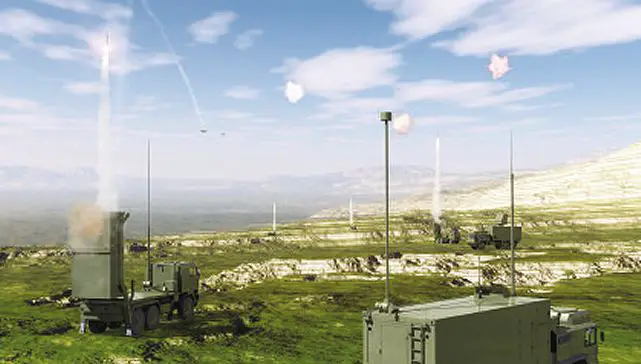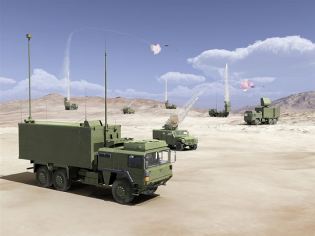The MBDA VL MICA (Missile d’interception et de combat aérien, “Interception and Aerial Combat Missile”) is an anti-air multi-target, all-weather, fire-and-forget short and medium-range missile system. It is intended for use both by air platforms as individual missiles as well as ground units and ships, which can be equipped with the rapid fire VL MICA Vertical Launch System. VL MICA provides an optimum level of defense against a wide range of targets, including fixed-wing aircraft, helicopters and UAVs. Moreover, its characteristics (fire-and-forget guidance, vertical launch) make it particularly effective against saturation attacks carried out by a large number of low signature targets such as guided bombs or missiles and cruise missiles attacking from any direction (360° coverage). Thanks to its range and altitude, VL MICA’s performance in providing area defense, the protection of highly sensitive civilian or military assets as well as cover for maneuvering land forces is unmatched by any other low-level air defense system.
On January 28, 2025, the French Ministry of Armed Forces released a statement announcing the strategic acquisition of 8 additional VL Mica air defense missile launcher vehicles. This decision is part of France’s ongoing effort to modernize and enhance its defense capabilities, ensuring that its military remains prepared to face a wide range of evolving threats. The new French air defense system was deployed during the Paris 2024 Olympic and Paralympic Games, where the VL Mica systems played a vital role in securing the skies above Paris against potential air and missile threats.
|
| Missile launcher unit |
|
Vertical Launch MICA (VL MICA) is a short-range, ground-based air defense system deploying the MICA fire-and-forget missile, currently the only missile in the world capable of being fitted with either a heat-seeking homing head (VL MICA IR) or with an active, radar homing head (VL MICA RF). This unique capability ensures an outstanding kill probably, even in severe IRCM-ECM environments. The latest version of the VL Mica launcher unit uses a Renault truck chassis with each 4 to 6 missile canister mounted at the rear of the chassis.
|
| Missile |
|
The 112kg vertical launch missile is built in two versions, an active radar Mica RF with a pointed nose cone and a passive infrared imaging Mica IR with a rounded nose. Mica RF has been in production since 1996 and the Mica IR since 2000. Both sensors are robust against jamming. The slim body structure of the missile is identical to that of the original air-to-air Mica. The four L-shaped guidance fins installed at the rear of the body are movable.
|
| Command and control vehicles |
|
The organization of a typical VL MICA unit is based on a vehicle-mounted shelter-protected Tactical Operations Centre (TOC) also known as the Platoon Command Post (PCP). This is capable of carrying out all Command, Control and Coordination functions, including real-time engagement, mission planning, system monitoring and connection with the higher level of command. The TOC remotely controls a tri-dimensional radar mounted on a separate vehicle and three to six vertical launcher units also mounted o vehicles.
At IDEX 2011 defense exhibition, MBDA is revealing two new systems to coordinate the firing of Mistral and VL Mica. The IMCP (Improved Missile Control Post) is the first element of this setup. It integrates, within a shelter mounted on an all-terrain vehicle, a command and control unit and latest generation 3D radar capable of detecting and identifying aerial targets at ranges of 80 km. IMCP is an evolved version of the Mistral Coordination Post of which more than 40 have already been sold. It comprises an operator console very carefully ergonomically designed to provide a workspace within which the unit commander can carry out his mission under optimum conditions.
The second new system presented by MBDA is the PCP (Platoon Command Post). This modular command system is a direct derivative of the VL MICA Tactical Operations Centre (TOC) which has been developed in close cooperation with the French Air Force. PCP allows the commander to control multi-layer surface-to-air defense units, linking Mistral and VL MICA missile launchers. The system carries out the interface role between the various units responsible for coordinating the air space and, if necessary, its self-coordination with the PCP units deployed in neighboring zones. The detection, identification and tracking functions are carried out via a link to the IMCP which, in this case, is completely remote-controlled by one of the three operators manning the PCP.
|
| Combat use |
|
A VL Mica unit consists of mobile launch units, each carrying 4 – 6 launchers and a tactical operation center which also links via fiber-optic line to the remote-controlled radar, and via VHF radio link, to the firing units. This structure makes it easy to deploy, easy to integrate in within a wider global air defense structure and gives the system a high level of survivability. A VL MICA unit can ensure seamless area protection versus a wide variety of targets, including fast maneuvering combat jets and cruise missiles.
|
| |
| Specifications |
| Back to top |
|
Armament
|
|
Four missiles MICA by the launcher unit
a
a
|
|
Country user
|
|
Botswana, Denmark, France, Morocco, Oma, Saudi Arabia, Thailand
|
|
Designer Country
|
|
France
|
|
Radar and support Vehicles
|
|
Tactical Operation Centre (TOC) also named Platoon Command Post (PCP), vertical launcher unit and IMCP (Improved Missile Control Post
|
|
Crew
|
|
3 operators
|
|
|
Operational performance
|
|
- 10 min. for full deployment
- 15 minutes for launcher reload
- 4 different targets in 6 seconds.
|
|
Weight vehicle
|
|
? kg
|
|
Speed vehicle
|
|
? km/h maximum speed on road
|
|
Missile
|
|
Range max: 20 km
Altitude max: 9,200 m
Warhead: 12 kg
|
|
Vehicle Dimensions on road
|
|
Lenght, ? m; Width, ? m; Height, ? m
|
|
|
| |
|

































